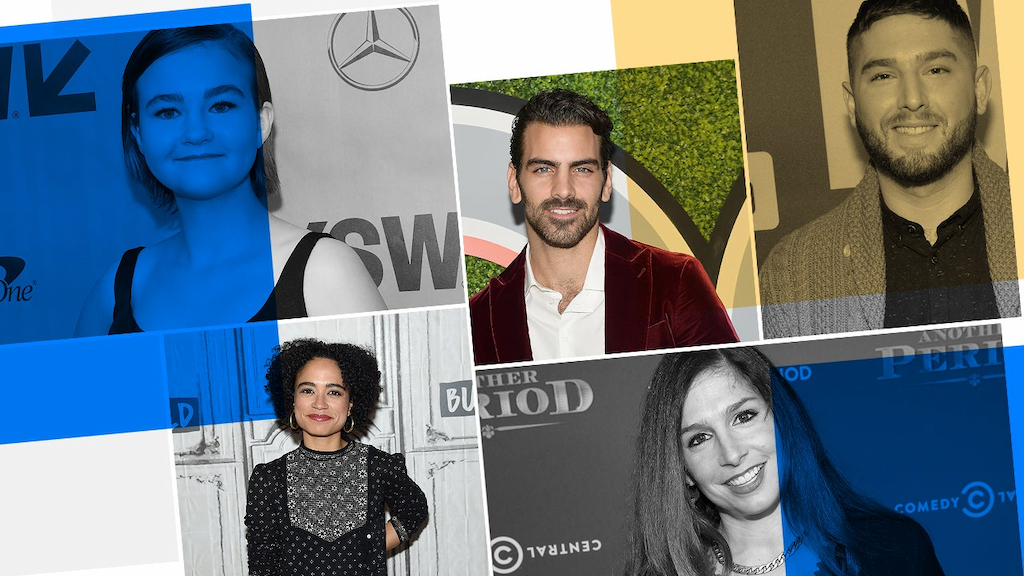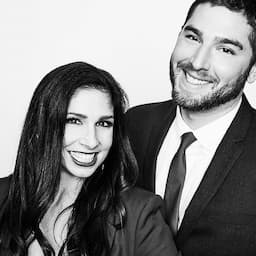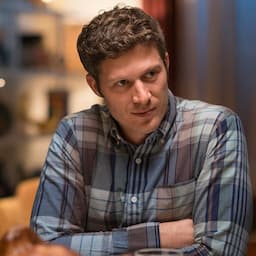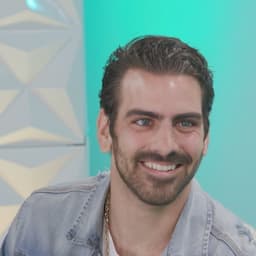Shoshannah Stern, Josh Feldman and Nyle DiMarco are just a few of the rising deaf stars taking control of how deaf stories are written and portrayed on stage and screen, telling ET, “we’ve always been here.”
“It’s time for us to take our place in the media, because in the everyday world, we’ve always been here -- and it’s time for the ‘genetic makeup’ of television, so to speak, to start to reflect that,” deaf writer and actor Josh Feldman tells ET, referring to a large community of people historically underrepresented in Hollywood who’ve been calling more urgently for a change.
Feldman and Shoshannah Stern -- the co-creators and co-stars of This Close -- are part of a rising wave of visibility for the deaf community, with more nuanced (and standout) portrayals appearing in projects both popular and prestigious. Recently renewed for a second season, the Sundance Now series is the first to be created by and star deaf actors. The success of the show follows Freeform’s Switched at Birth, the first mainstream series to feature multiple deaf and hard-of-hearing series regulars, which recently ended after five seasons.
Currently in theaters is John Krasinski’s near-future horror film A Quiet Place starring rising 15-year-old deaf actress Millicent Simmonds, who first broke out with Todd Haynes’ 2017 film Wonderstruck. The film, which features dialogue predominantly in American Sign Language, is on track to become one of the year’s big box office success stories and could be an awards season contender, like The Silent Child, which won the 2018 Oscar for Live Action Short Film. The win for the scripted film about a deaf child learning to communicate represented a significant boost for onscreen use of sign language -- the film features British Sign Language -- and deaf representation in the past year.
The Silent Child; Baby Driver, co-starring deaf comedian and scene-stealer CJ Jones; and The Shape of Water, which features period-specific ASL as a way for the film’s mute character to communicate, marked the first time that films featuring ASL or a deaf character were nominated for an Oscar since 2006’s Babel. (The Shape of Water, which stars all-hearing actors, won multiple awards, including Best Picture.)
The Silent Child writer and star Rachel Shenton, who has been active in the deaf community since her father lost his hearing after undergoing chemotherapy, signed her Oscar acceptance speech, making good on a promise to the film’s young star Maisie Sly, who plays the character taught BSL by a social worker. “Our movie is about a deaf child being born into a world of silence. It’s not exaggerated or sensationalized for the movie. This is happening,” Shenton said, before concluding: “Deafness is a silent disability. You can’t see it, and it’s not life-threatening, so I want to say the biggest of thank-yous to the Academy for allowing us to put this in front of a mainstream audience.”
On Broadway, a revival of Mark Medoff’s 1979 drama Children of a Lesser God opened this spring to rave reviews for Joshua Jackson (who learned ASL to sign and speak the majority of his performance) and Lauren Ridloff, a deaf newcomer who recently transitioned from tutor to actor with a bit part in Wonderstruck. The production follows Deaf West Theatre’s 2015 Broadway revival of the musical Spring Awakening, with hearing and non-hearing actors sharing the lead roles. Earning a Tony Award nomination for her debut performance, Ridloff sees the show as an opportunity to “speak for the community of people and actors who have been living on the fringe.” Meanwhile, her husband was an ASL consultant on A Quiet Place. “It feels like this is a great time for the creative talents of the community,” she adds.
Another major voice for the deaf community is actor and model Nyle DiMarco. After winning America’s Next Top Model in 2015, he went on to become a champion on Dancing With the Stars and has since teamed up with the ASL App, which is trying to make sign language accessible to all people. In addition to appearing on This Close, he’s now a producer on Children of a Lesser God. “With deaf artists working behind the scenes, not only do you see authenticity on stage, but it also builds the credibility of deaf artists within the entertainment industry,” says DiMarco.
Medoff’s play, about the romance between a hearing teacher and his deaf student, has pride of place in the history of deaf representation -- however imperfect, it’s one of the only well-known stories about deaf experience. Marlee Matlin, Hollywood’s most recognizable deaf artist, won a Best Actress Oscar for the 1986 film adaptation. Stern starred in a 30th anniversary production at L.A.’s Deaf West Theatre in 2009. “It’s always such a thrill for me to see my native language being showcased, and I always feel a real sense of pride when I see work from deaf actors, especially when deaf people are a part of the creative process,” Stern says of seeing the new Broadway revival.
But Stern also hopes audiences ask themselves an important question: “How would the play be different if we could see Sarah [the deaf student] as she sees herself, rather than through the perspective of a hearing man?” It’s one that gets at the heart of how Stern and many deaf artists feel about seeing deaf characters represented in works made by and for hearing people. “It’s incredibly easy for people to become comfortable with accepting that as the status quo,” Stern says of such portrayals, which have dominated in the absence of deaf creators behind the scenes. “To the point where I often have to push back in real life and say, ‘You know what, no, that isn’t actually my reality. It’s my reality as described by someone else who hasn’t actually experienced it for themselves.’ It’s disorienting, and often lonely, to have to fight for ownership over that -- to defend your personal experience as what it is, as opposed to what someone on the outside looking in thinks it is.” In fact, her experience on Jericho, when showrunner Carol Barbee allowed her to rewrite a scene she was having trouble with, was a catalyst for creating This Close.
While it’s heartening to see more complex narratives involving deaf characters, there’s a hope that they’re opening doors for more stories created by deaf artists themselves. As DiMarco says of his work on Children, by fostering the credibility of deaf artists -- as producers, writers and creators of their own narratives -- “we'll be able to produce our own shows and bring you a completely new perspective never seen before.”
“It seems to me that in the media, minorities have almost always been introduced to the mainstream through a member of the majority,” Stern says, nodding to the rising visibility of deaf characters in mainstream projects. “That first step is groundbreaking. But if you don’t build anything on that broken ground, then it’s just ground that’s been torn up. We have to collectively push to keep that momentum going forward. There are so many fresh and new ideas out there, they just need a space to exist in.” Matlin, who joined Quantico’s third season as a former FBI agent who lost her hearing in a bomb blast, sees more room for such stories on TV than in film. “There are many, many deaf actors, writers, directors and producers -- and lots of stories to tell,” the actress told The New York Times last fall of the growing streaming television landscape, where This Close lives and where shows like Hulu’s Difficult People and, notably, Netflix’s Master of None have experimented with deaf storytelling.
On the latter, Broadway actress Treshelle Edmond plays a deaf bodega clerk named Maya in the episode “New York, I Love You.” When the episode shifts to her narrative, the scene goes quiet, focusing the viewer's attention on the use of ASL and Maya’s interactions with friends and customers, ending on a hilarious conversation about wanting more sexual satisfaction from her boyfriend. “Sexual situations are rarely discussed when it comes to deaf and hard-of-hearing people on screen, so I hope this showed people that we all share things in common,” Edmond told Essence about appearing in the episode, with creator Aziz Ansari revealing to Vulture that the moment was something he’d not seen before. “It was fun to do it about that instead of how sad it is or whatever, you know?”
Ultimately, that narrative or the ones on This Close aren’t going to be enough to represent an entire community, Stern says. “We need as many narratives as we can get, and one of our bigger challenges is to keep pushing for that. We need representation everywhere, not just onstage or in front of the camera, but behind the camera, behind the scenes, as creative partners in the process. We need people consulting, people writing, people directing, hell, people holding the damn boom, because why not?”
One place to start? Stern, Feldman and DiMarco urge aspiring deaf artists to first believe in themselves and the stories they have to tell. DiMarco’s best advice really applies to everyone: “Embrace your own identity first before you try to do anything,” says DiMarco, who came out as sexually fluid on Twitter in 2015. “I know from experience that when you struggle with who you are, you will have a hard time navigating in the industry and harder time being true to yourself and bringing authenticity to your work.” Feldman, who, like his character on This Close, is gay, adds, “At a young age, I remember wondering just exactly what kind of gay, deaf adult I could grow up to be if I couldn’t find myself on television or in the movies.… As I always tell anyone, there’s no one better than yourself to tell your own story. When someone tries to tell you how they think you should tell your own story, stay the course and remember at the end of the day, it’s your story, not theirs.”
That’s the ethos that led Feldman and Stern to This Close. “Find a way to tell the story you want to tell, not the story you think people want you to tell,” Stern says. “We originally pitched This Close as Kate being deaf and Michael being hearing because we were so conditioned to seeing a deaf character paired with a hearing character that it didn’t even occur to us that we should try to make both characters deaf until we decided to just do it ourselves. Ironically, that’s what ended up selling the show, because that’s exactly what people ended up really responding to,” Stern says. “The moral of the story is listen to yourself, because nobody else will.”
As for the prevalence of deaf characters and the use of ASL in major Hollywood films, there’s evidence that such portrayals are evolving, too. “Usually they’re victims, or their deafness creates some sort of jeopardy,” Matlin told the Times in October of deaf characters on film. But in A Quiet Place, Simmond’s character’s deafness works to the advantage of her family -- whose knowledge of ASL helps them evade the movie’s monsters -- and allows her the upper hand in the end. (“She’s my hero,” DiMarco says.) For her part, Simmonds praised the movie for “using the language of [the deaf] community and culture in a creative way,” adding, “I hope this film inspires other writers to include more actors who are deaf and to use sign language in different ways.”
“There’s one moment in Downsizing, which I just saw, that really encompassed my hopes for the future,” Stern says, describing a scene when Matt Damon and Hong Chau walk past a couple communicating in ASL. “They were having this incredibly brief but hilariously nuanced argument. The woman actually tells him to eat shit. I think I watched that moment maybe six times.
“I loved it, because in that moment, it shows deaf people as simply existing in the world,” Stern continues. “I would love to see deaf actors in roles that aren’t about them being deaf -- as villains, as love interests, as comic relief... There are already deaf professionals who do any and all kinds of work in the world, you just have to hold up a mirror to that.”
--Additional reporting by David Batista, Denny Directo and Rande Iaboni
RELATED CONTENT:



